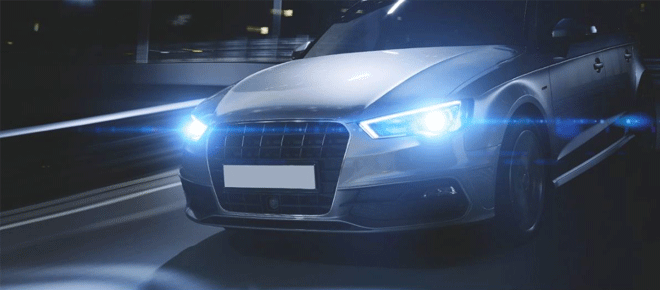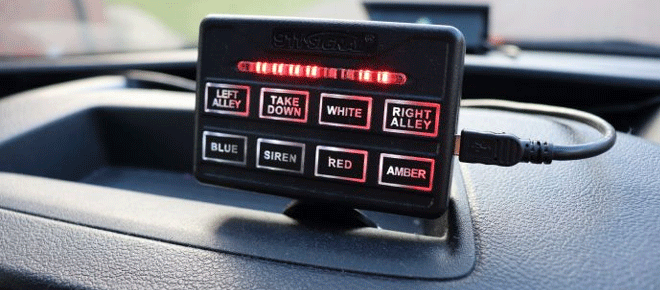the smallest cars in the world

Peel P50:
The Peel P50 is a unique and iconic microcar that was originally manufactured in the 1960s by the Peel Engineering Company on the Isle of Man. It is considered to be one of the smallest production cars ever made. Here are some key details about the Peel P50:
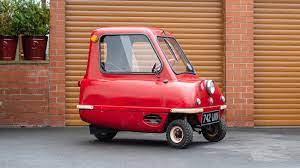
-
Size: The Peel P50 is incredibly compact, measuring just 54 inches (137 cm) in length and 41 inches (104 cm) in width. It is a single-seater vehicle, meaning it can accommodate only the driver.
-
Design: The car has a simple and minimalist design with a fiberglass body and a single front door. It features three small wheels, making it a three-wheeled vehicle.
-
Engine: The original Peel P50 was powered by a tiny 49cc two-stroke engine, which produced a modest amount of power suitable for city driving.
-
Performance: Due to its small size and low-powered engine, the Peel P50 had a limited top speed, typically around 30 mph (48 km/h). It was primarily designed for short urban commutes.
-
Production: The Peel P50 was produced in limited quantities, and it is estimated that only around 50 units were ever manufactured.
-
Famous Appearance: The Peel P50 gained widespread recognition and popularity when it was featured in an episode of the British TV show "Top Gear." Host Jeremy Clarkson drove the car through the BBC Television Centre and around London, showcasing its tiny size and quirky design.
-
Revival: In recent years, the Peel Engineering Company introduced a modernized version of the Peel P50 called the Peel P50 Mark 2, which retains the original's unique design while incorporating some modern features.
The Peel P50 has become a cult classic and is admired for its adorable and unconventional appearance. Its limited production numbers and historical significance have made it a sought-after collector's item. Despite its diminutive size, the Peel P50 has left a lasting impression on automotive enthusiasts and remains an iconic piece of automotive history.
Smart Fortwo:
The Smart Fortwo, often stylized as smart fortwo, is a unique and compact two-seater car manufactured by Smart, a subsidiary of Mercedes-Benz. The Fortwo is designed for urban driving, emphasizing fuel efficiency, ease of parking, and maneuverability in congested city environments. Here are some key details about the Smart Fortwo:
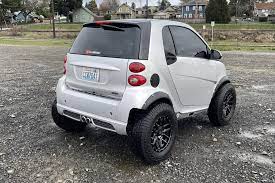
-
Compact Size: As the name suggests, the Smart Fortwo is designed to accommodate two passengers. It is one of the smallest production cars on the market, with a length of around 2.69 meters (approximately 8 feet and 10 inches).
-
Origin: The Smart Fortwo was originally developed by the Swiss company Swatch and Daimler-Benz (now Daimler AG) in the late 1980s. The name "Smart" is an acronym for "Swatch Mercedes ART."
-
First Generation: The first-generation Smart Fortwo, known as the "City Coupe," was introduced in 1998. Its innovative design, compact size, and distinctive appearance made it an eye-catching city car.
-
Second Generation: The second-generation Smart Fortwo was launched in 2007 and featured some design updates and improvements. It offered various engine options, including gasoline, diesel, and electric variants.
-
Third Generation: The third-generation Smart Fortwo, introduced in 2014, brought further improvements in design and technology. It also marked the beginning of Smart's transition to an all-electric brand in certain markets.
-
Electric Versions: Smart has been focusing on electric vehicle technology, and in some regions, the brand exclusively offers electric versions of its cars, including the Fortwo Electric Drive (EQ).
-
Safety Features: Despite its small size, the Smart Fortwo is engineered with safety in mind. It includes a reinforced safety cell and advanced safety features to protect occupants.
-
Maneuverability: One of the Fortwo's standout features is its exceptional maneuverability. Its small turning radius allows for easy U-turns and parking in tight spaces.
-
Customization: Smart offers various customization options for the Fortwo, allowing buyers to personalize their cars with different colors, trims, and accessories.
The Smart Fortwo has gained popularity as a practical and eco-friendly option for urban commuters. Its compact size, fuel efficiency, and electric powertrain options have made it a popular choice for city driving, especially in congested metropolitan areas where parking and maneuverability are essential considerations.
Isetta:
The Isetta is a unique and iconic microcar that was originally produced in Italy by Iso SpA in the 1950s. It is known for its distinctive design, which features a front-opening door and a single front wheel. The Isetta is often considered one of the most memorable microcars of its time. Here are some key details about the Isetta:
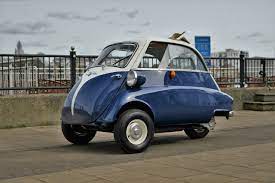
-
Bubble Car Design: The Isetta is commonly referred to as a "bubble car" due to its egg-shaped body and compact size. It has a charming and quirky appearance that makes it stand out from traditional cars.
-
Front Door: One of the most defining features of the Isetta is its front door, which is hinged at the front and opens like a refrigerator door. This design was implemented to allow easy entry and exit in tight parking spaces.
-
Seating Arrangement: The Isetta is a two-seater microcar, with the driver sitting in the front and the passenger seated directly behind. The two occupants are seated in a tandem configuration.
-
Engine Location: The engine of the Isetta is located at the rear, powering the single rear wheel. Early models were equipped with a small single-cylinder engine, usually around 250cc, which provided modest power for city driving.
-
Manufacturers: While the Isetta was originally designed and produced by Iso SpA in Italy, the microcar gained popularity and was also manufactured under license by various companies in different countries. BMW, in particular, produced its own version of the Isetta, known as the BMW Isetta.
-
Affordable and Fuel-Efficient: The Isetta was designed to be an affordable and fuel-efficient urban transportation option. It became popular in post-war Europe as a practical and economical solution for city commuting.
-
Enduring Legacy: The Isetta's popularity has endured over the years, and it is still celebrated as a classic and charming microcar. Vintage models are cherished by car enthusiasts and collectors worldwide.
-
Cultural References: The Isetta has appeared in various films, TV shows, and other media, adding to its cultural significance and recognition.
The Isetta's unique design and historical significance have made it an enduring symbol of the microcar era. Its compact size and distinctive features have left a lasting impact on automotive design and continue to be appreciated by enthusiasts and car lovers to this day.






